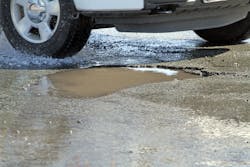The vehicle suspension’s job is to provide a good ride, handling and control. While this may seem a simple task, it is anything but. Numerous factors come into play that impact the suspension’s proper operation.
Among the suspension’s various functions:
- Supports vertical loads – the vehicle’s tare (empty) weight and when loaded.
- Transfers loads from the vehicle to the ground via structural members, axles, wheels and tires.
- Maintains axle and wheel position.
- Provides compliance and isolation from road disturbances via springs and bushings for ride comfort and to maintain tire contact with the ground.
- Delivers adequate stability and cornering stiffness for handling performance and safety.
To accomplish all of this, the suspension must minimize frame movement and excitation, control vertical movement and lateral stiffness and provide damping to eliminate vibration and oscillation.
Characteristics
Ride control technology, in the form of shock absorbers, struts and related products, contributes to ride quality in vehicles. This technology, says Robert Nossal, product engineering manager, Gabriel Ride Control, can be specialized to vehicle type and end use to ensure top performance across the wide range of vehicle applications.
Gabriel (www.gabriel.com) is the inventor and an industry leader in the design, engineering, development and production of automotive ride control technology in North America. It operates in both the aftermarket and original equipment manufacturer (commercial, industrial and recreational vehicle) segments under the brand names Gabriel in the U.S. and Canada and GRC in Mexico.
“In light vehicle applications, the design of the valve in shocks and struts drives performance and durability,” he explains. “Ride quality and comfort at any given velocity is dependent on valve design and tuning.
“To think of it another way, valve performance is velocity-dependent and, therefore, valve designs must be tunable to offer different levels of vehicle control across a broad range of suspension travel velocities.”
Ride control technology companies can tailor the dynamic targets of their products based on valve design. By way of example, Nossal notes that all Gabriel Ride Control shocks and struts “are designed and tuned to provide proper damping control for harsh inputs, and to provide less aggressive damping where only basic body control is required to react to body pitch and roll motions.”
The company’s engineering team’s “expert understanding” of damping valve technology allows it to market its products specifically, based on the ride performance characteristics delivered by each individual valve design, he says.
Heavy Duty Vehicles
While valve design is also critical to top performance in heavy duty vehicles, such as Class 8 trucks, there are additional characteristics of ride control technology that have a great impact on both ride quality and service life, Nossal points out. These include fade performance, tensile strength and hydraulic lock.
“Fade performance is the ability of a shock absorber to generate consistent damping force across a temperature range,” Nossal says. “In many cases, at high temperatures, the oil within the shock absorber can begin to shear and aerate. Damping forces are then reduced, as the air absorbed into the oil is compressible and, therefore, will not generate the required damping force.”
The fade performance of ride control technology is largely tied to the type and quality of the oil being used as the damper fluid, he adds.
“Top-quality damper fluid has additives that both enhance its damping capabilities and control shear, ensuring greater fade performance over the product’s lifetime,” Nossal says.
Each ride control technology manufacturer generates its own damper fluid formula, he notes, and “so fade performance can vary widely among different brands.”
Tensile Strength
Tensile strength is also critical to long-term performance in heavy duty ride control applications.
Aggressive rebound events can place a great deal of strain on ride control products, particularly at the points at which they attach to the vehicle chassis, notes Nossal. In extreme cases, or if the shock absorber is weakened, such events can rip the shock apart.
“Different construction methods for shock absorbers can offer higher pull force values, allowing the product to sustain greater or repeated force before failing,” he points out.
“Generally, split/welded eye rings on shock absorbers fail at lower pull force values. Solid forged eye-rings, such as those available on Gabriel heavy duty ride control products like the Fleetline product line, generally have greater tensile strength and fail at far higher pull force values.
“Customer requirements and end use influence how important tensile strength is to performance, as some vehicles must be capable of withstanding a greater number of or more severe, aggressive rebound events than others.”
Hydraulic Lock
Another key component of heavy duty shock absorber performance is the presence of a hydraulic lock, says Nossal. This feature instantly restricts fluid flow within the shock absorber during rebound events.
He explains that this fluid flow restriction increases the amount of energy absorbed by the ride control product, and that provides two benefits for end users:
- It ensures that end users do not feel aggressive rebound events as strongly, improving ride quality.
- It reduces the strain put onto the shock absorber components, lengthening service life by reducing the likelihood of failure.
In Sum
“Together, design for fade performance, tensile strength and hydraulic lock contribute to body control and ride comfort, as well as long service life in heavy duty vehicles,” concludes Nossal. “Top-quality oil formulations, strength in attachment points and hydraulic lock features deliver the best quality ride over the longest service life, and heavy duty vehicle operators can benefit from these product characteristics when choosing ride control technology based on their vehicles’ end use.
“Similarly, light vehicle end users with an understanding of the importance of valve design can choose how to prioritize cost, body control and comfort in their selection of ride control technology.”
About the Author

